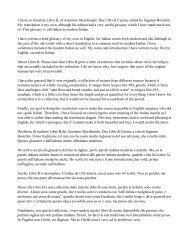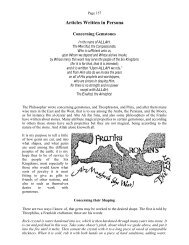How to Milk an Almond Stuff an Egg And Armor a Turnip A ...
How to Milk an Almond Stuff an Egg And Armor a Turnip A ...
How to Milk an Almond Stuff an Egg And Armor a Turnip A ...
Create successful ePaper yourself
Turn your PDF publications into a flip-book with our unique Google optimized e-Paper software.
145<br />
M<strong>an</strong>gelsdorf, Paul C., Corn: Its Origin Evolution <strong>an</strong>d Improvement. Harvard University Press,<br />
Cambridge, Mass. 1974.<br />
McGee, Harold, On Food <strong>an</strong>d Cooking: The Science <strong>an</strong>d Lore of the Kitchen, Consumer's Union,<br />
Mt. Vernon, N.Y. 1984.<br />
Paris, Harry S. et al., “The Cucurbitaceae <strong>an</strong>d Sol<strong>an</strong>aceae illustrated in medieval m<strong>an</strong>uscripts<br />
known as the Tacuinum S<strong>an</strong>itatis,” Annals of Bot<strong>an</strong>y Vol.103:8 (2009), webbed at<br />
http://www.hort.purdue.edu/newcrop/TS_aob.pdf<br />
Simmons, Al<strong>an</strong> E., Growing Unusual Fruit, Walker <strong>an</strong>d Comp<strong>an</strong>y, N.Y. 1972.<br />
Simoons, Frederick J., Food in China, CRC Press, Boca Ra<strong>to</strong>n 1991.<br />
Spencer, Judith tr., The Four Seasons of the House of Cerruti (late fourteenth century Itali<strong>an</strong>).<br />
Vesco, Clotilde, Cucina Fiorentina fra Medioevo e Rinascimen<strong>to</strong>, 1984.<br />
Wadsworth, Capt. John, Chocolate: or, An Indi<strong>an</strong> Drinke. London, 1652. Apparently tr<strong>an</strong>slated<br />
from a book by Melchor de Lara, "Physiti<strong>an</strong> General for the Kingdome of Spaine", 1631.<br />
Whitaker, Thomas W., “Americ<strong>an</strong> Origin of the Cultivated Cucurbits,” Annals of the Missouri<br />
Bot<strong>an</strong>ical Garden, 1947.<br />
Wilson, C. Anne, Food <strong>an</strong>d Drink in Britain: From the S<strong>to</strong>ne Age <strong>to</strong> recent times, Harper <strong>an</strong>d<br />
Row 1974. This is <strong>an</strong> extraordinarily careful <strong>an</strong>d detailed book.<br />
This essay is still growing; if you come across relev<strong>an</strong>t information, please write.<br />
Scottish Oat Cakes: A Conjectural Reconstruction<br />
"the only things they take with them [when riding <strong>to</strong> war] are a large flat s<strong>to</strong>ne placed between<br />
the saddle <strong>an</strong>d the saddle-cloth <strong>an</strong>d a bag of oatmeal strapped behind. When they have lived so<br />
long on half-cooked meat that their s<strong>to</strong>machs feel weak <strong>an</strong>d hollow, they lay these s<strong>to</strong>nes on a fire<br />
<strong>an</strong>d, mixing a little of their oatmeal with water, they sprinkle the thin paste on the hot s<strong>to</strong>ne <strong>an</strong>d<br />
make a small cake, rather like a wafer, which they eat <strong>to</strong> help their digestion." (Froissart’s<br />
Chronicles, Penguin Books tr<strong>an</strong>slation.)<br />
So far as I know, there are no surviving period recipes for oat cakes. This article is <strong>an</strong> attempt<br />
<strong>to</strong> reconstruct them, mainly on the basis of Froissart’s brief comment.<br />
Rolled oats—what we <strong>to</strong>day call “oatmeal”—are a modern invention. I assume that "oat meal"<br />
in the middle ages me<strong>an</strong>t the same thing as "meal" in other contexts—a coarse flour. The only<br />
other ingredient mentioned is water, but salt is frequently omitted in medieval recipes—Platina,<br />
for inst<strong>an</strong>ce, explicitly says that he doesn’t bother <strong>to</strong> mention it—so I have felt free <strong>to</strong> include it.<br />
The oat cakes Froissart describes are field rations, so unlikely <strong>to</strong> contain <strong>an</strong>y perishable<br />
ingredients such as butter or lard, although they may possibly have been used in other contexts.<br />
Consistent with these comments, the following is my conjectural recipe for oatcakes as they<br />
might have been made by Scottish troopers c. 1400:<br />
½ c steel-cut oats ¼ t salt ¼ c water<br />
Combine all ingredients <strong>an</strong>d let the mixture st<strong>an</strong>d for at least fifteen minutes. Make flat cakes<br />
¼" <strong>to</strong> ⅜" in thickness, cook on a medium hot griddle, without oil, about 3-5 minutes. The result is<br />
a reasonably tasty flat bread, though inclined <strong>to</strong> be crumbly.<br />
(An earlier version of this article was published in Serve it Forth: A Periodical Forum for<br />
SCA Cooks, Volume I, Number 2 (April 1996). Information on that publication, which<br />
unfortunately is no longer coming out, is at home.pcisys.net/~mem/sif_home.html.)





